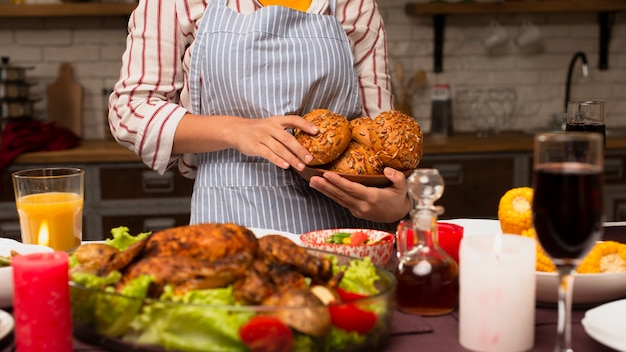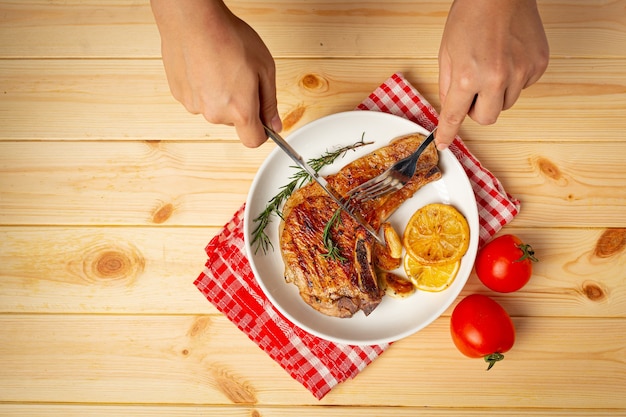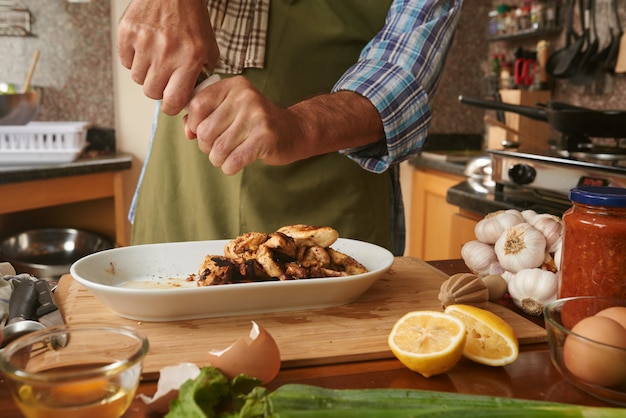Ah, roast dinners. The quintessential Sunday tradition, a gathering of loved ones around a table piled high with golden-brown meat, fluffy potatoes, and vibrant vegetables. There’s a real magic to it, isn't there? But let's be honest, getting that roast absolutely spot-on can feel like a bit of a gamble. You're either left with dry, overcooked meat, or the potatoes have lost their crisp and those veggies just aren’t quite right. But don’t worry, my fellow food enthusiasts, I'm here to share all my secrets, all my hard-won knowledge to help you conquer the art of roast cooking. We'll cover everything from selecting the perfect cut to creating that glorious gravy, and we'll even delve into some seriously delicious side dishes. So, grab your favourite mug, settle in, and let’s get cooking!
(Part 1) Meat Matters: Picking the Perfect Cut

The star of the show is the meat, and getting this right is the foundation of a truly epic roast. When it comes to traditional roasts, I'm all about cuts with a bit of fat on them - think beef, lamb, or pork. Those beautiful fat layers render down as the meat cooks, adding a depth of flavour and keeping everything juicy and tender.
Beef: The Classic Choice
A good cut of beef is a real showstopper. For a truly luxurious roast, nothing beats a rib of beef. It's a rich, flavourful cut with enough fat to create a beautiful, succulent roast. But if you’re on a budget, a shoulder roast is a great alternative. It's perfect for slow roasting and develops a wonderfully tender texture. Just make sure to ask your butcher for a good cut from a good animal, and always go for prime cuts if you can.
Lamb: For a Hearty Feast
Lamb brings a lovely, slightly gamey flavour to the table. For a classic roast, I always go for a leg of lamb. It's a great size for a family gathering and the bone-in piece adds a real depth of flavour. If you're serving a smaller group, a shoulder of lamb is another fantastic option. It's also a great cut for slow roasting, and it’s often a bit more affordable than a leg.
Pork: The All-Rounder
Pork is a real workhorse when it comes to roasting. It’s affordable, cooks up beautifully, and is incredibly versatile. A pork loin is a classic choice, lean and tender, and cooks beautifully. If you want something a bit more indulgent, go for a pork shoulder. It’s got a good amount of fat, which means a richer flavour and beautifully tender meat.
(Part 2) The Prep Game: Getting Ready for Roast Perfection

Okay, now that we've got our meat chosen, it's time to get prepped. This might seem like a simple step, but it's crucial for creating that truly perfect roast.
Seasoning: The Art of Flavour
Don’t underestimate the power of seasoning. It’s the key to unlocking the full flavour potential of your roast. A simple sprinkle of salt and pepper is a must, but I like to go a little further. I often use a mix of fresh herbs, like rosemary, thyme, and garlic. It adds a real depth of flavour. And don’t forget a couple of bay leaves – they add a wonderful, earthy aroma to the whole cooking process.
The Rub: Taking Flavour to the Next Level
For an even more flavourful crust, try a good rub. You can keep it simple with paprika, garlic powder, and onion powder, or get really creative with your spice blend. A good rub helps to create a beautiful golden crust on the meat, and the flavour really permeates the meat as it cooks.
Fat is Your Friend: For Tenderness and Moisture
Remember that fat we mentioned earlier? It's not just about flavour – it plays a crucial role in keeping your roast tender and juicy. Before you start cooking, give your meat a good pat with a little olive oil or butter. It helps create a wonderful crispy skin and keeps the meat moist throughout the cooking process.
(Part 3) Temperature Control: The Key to Perfect Doneness

Now we’re getting into the nitty-gritty. Getting the temperature right is absolutely essential for a perfect roast. We want to avoid undercooked meat at all costs, but we also don’t want to overcook it and end up with something dry and tough.
Oven Temperature: Finding the Right Heat
A general rule of thumb for roasting is to use a medium-high temperature, usually around 180 degrees Celsius (350 degrees fahrenheit). This allows the meat to cook evenly and develop a lovely, crispy crust.
meat thermometer: Your Ultimate Tool
Now, listen up, this is crucial! Always use a meat thermometer. It's the only way to be absolutely sure your roast is cooked to perfection. You can find these in most supermarkets and online, and it's worth investing in one if you don't have one already.
Resting: The Secret to Tenderness
Once your roast is cooked, it's important to let it rest for at least 10 minutes before carving. This allows the juices to redistribute throughout the meat, creating a truly tender and delicious result. Think of it as the final step to achieving perfect doneness.
(Part 4) roasting time: How Long is Long Enough?
Okay, so now we need to figure out how long to cook your roast. The roasting time will depend on the type of meat and the size of your roast.
Beef: For a Succulent Roast
For a rib of beef, aim for about 20-25 minutes per pound at 180 degrees Celsius (350 degrees Fahrenheit) for medium-rare. If you like your beef well-done, add another 5-10 minutes. Always check with a meat thermometer to make sure it reaches your desired internal temperature.
Lamb: A Balanced Flavour
A leg of lamb typically takes around 15-20 minutes per pound at 180 degrees Celsius (350 degrees Fahrenheit). You can cook it to your preferred level of doneness, but for medium, aim for an internal temperature of 63 degrees Celsius (145 degrees Fahrenheit).
Pork: Keeping it Safe
A pork loin will cook a bit quicker than beef or lamb, usually around 15 minutes per pound at 180 degrees Celsius (350 degrees Fahrenheit). Always make sure your pork is cooked to an internal temperature of 74 degrees Celsius (165 degrees Fahrenheit). It’s important to cook pork thoroughly to ensure food safety.
(Part 5) The Great Gravy Debate: A Symphony of Flavour
Gravy! The glorious sauce that elevates a roast dinner from good to truly magnificent. It's a crucial element, but let's be honest, making good gravy can feel like a bit of a culinary gamble.
homemade gravy: The Real Deal
Forget the jarred stuff! Nothing compares to the flavour of homemade gravy. It’s incredibly easy to make, and it’s worth the extra effort.
Pan Drippings: The Flavour Foundation
The secret to delicious gravy is those pan juices – they’re packed with flavour! Once your roast is cooked and resting, carefully pour the pan juices into a saucepan.
Flour: The Thickening Magic
To thicken your gravy, add a tablespoon of flour to the pan juices. Whisk until it's smooth, then slowly add some stock or wine, whisking constantly. Keep whisking until the gravy reaches your desired thickness.
Seasoning: The Finishing Touches
Don’t forget to season your gravy! I always add a pinch of salt and pepper, and a little bit of Dijon mustard for a lovely bit of tang.
(Part 6) Side Show: Roasting Companions
Now, let's talk about those wonderful sides that truly elevate a roast dinner to a truly spectacular feast. They're the unsung heroes of the table!
roast potatoes: The Crispy Perfection
Let's face it, roast potatoes are the undisputed king of roast dinner sides. They need to be perfectly crispy on the outside and fluffy on the inside, and that's a goal we’re going to achieve.
Here’s my tried-and-true method for perfect roast potatoes:
- Choose good potatoes. maris piper and king edward are great choices for roasting, as they hold their shape beautifully.
- Give them a good wash and cut them into large chunks. Don’t be afraid to give them a good scrub with a brush to remove any excess dirt.
- Boil the potatoes in salted water until they’re just tender. Don’t overcook them, or they’ll fall apart in the oven.
- Drain the potatoes and toss them with olive oil, salt, pepper, and herbs. I love using rosemary or thyme for a classic flavour.
- Spread the potatoes in a single layer on a baking sheet and roast them in the oven at 200 degrees Celsius (400 degrees Fahrenheit) until they’re golden brown and crispy.
yorkshire puddings: A Puffy Delight
Yorkshire puddings are another essential part of a traditional roast dinner. They can be a bit tricky, but they’re so worth the effort!
Here’s how to make Yorkshire puddings:
- Whisk together eggs, flour, and milk until smooth. Make sure there are no lumps – a smooth batter is key!
- Heat some beef dripping or vegetable oil in a baking tin. It needs to be nice and hot.
- Pour the batter into the hot tin and cook in the oven at 200 degrees Celsius (400 degrees Fahrenheit) for 20-25 minutes.
- The Yorkshire puddings are ready when they’re puffed up and golden brown.
Green Vegetables: The Fresh Counterpoint
A roast dinner needs a vibrant burst of colour and freshness, and that's where green vegetables come in. They balance out the richness of the meat and the potatoes beautifully.
- roast vegetables like broccoli, carrots, and parsnips for a sweet and savoury side. They’ll soak up the flavour from the roasting process and develop a lovely caramelized texture.
- Steam or blanch other vegetables like green beans, peas, or asparagus to keep them vibrant and crunchy.
(Part 7) Putting it All Together: The Grand Finale
Alright, we’ve done the prep, we’ve cooked the meat, we've got our sides ready – now it’s time to create a feast for the eyes!
The Plating Game: A Beautiful Presentation
A delicious roast dinner deserves a beautiful presentation. I always serve mine on a large platter, with the meat as the centerpiece.
The Trimmings: A Symphony of Flavours
Arrange your side dishes around the roast. I like to create a bit of a visual feast, so try to create a nice balance of colours and textures. Roast potatoes, Yorkshire puddings, and green vegetables all complement each other beautifully.
Gravy Time: The Final Touches
Finally, drizzle your delicious homemade gravy over the roast and side dishes. It's the finishing touch that brings everything together and creates a truly satisfying and flavourful meal.
(Part 8) Beyond the Basics: Exploring Flavour Adventures
Now that you've mastered the basics, it’s time to get creative and explore a whole world of flavour possibilities.
Spices: Adding Depth and Complexity
For a more adventurous flavour, try adding some spices to your roast. A sprinkle of cumin, coriander, or paprika can add a real punch of flavour.
Citrus: A Bright and Refreshing Twist
For a burst of freshness, add some lemon or orange zest to your roast. The citrus adds a bright, refreshing touch and really brings out the flavour of the meat.
Sweet and Savoury: A Harmonious Blend
For a truly unique flavour profile, try adding a few slices of apple or pear to your roast. The sweetness of the fruit balances perfectly with the savoury flavours of the meat, creating a delightful symphony of tastes.
(Part 9) Roast Dinner: A Global Journey
Roast dinners are a beloved tradition all over the world. It's a dish that transcends borders, bringing people together to share a delicious meal.
The American thanksgiving turkey
The American thanksgiving feast wouldn't be complete without a succulent roast turkey, often stuffed with herbs and vegetables. It's a tradition that brings families together to celebrate gratitude and joy.
The French roast chicken
In France, roast chicken is a staple. It's often served with roasted vegetables and a delicious red wine gravy. It’s a simple yet elegant dish that's perfect for a cozy dinner party.
The Argentinian Asado
In Argentina, the asado is a beloved tradition that involves slow-roasting different cuts of meat, like beef, pork, and lamb, over a charcoal fire. It's a real feast for the senses, with the smoky flavour of the fire infusing the meat.
FAQs
1. How do I know when my roast is cooked?
The best way to tell is by using a meat thermometer. Each type of meat has a safe internal temperature. Beef should be cooked to 145 degrees Fahrenheit for medium-rare. Lamb should be cooked to 145 degrees Fahrenheit for medium. Pork should be cooked to 165 degrees Fahrenheit.
2. Can I roast vegetables alongside the meat?
Yes, you definitely can! Roast vegetables like potatoes, carrots, and parsnips often go well with a roast dinner. Just make sure to place them on a separate baking sheet to avoid overcrowding.
3. What if my gravy is too thick or too thin?
If your gravy is too thick, add a little more stock or wine until you reach your desired consistency. If it’s too thin, whisk in a little bit of cornstarch or flour.
4. How do I prevent my roast from drying out?
The key is to keep the meat moist. Pat it with some olive oil or butter before cooking and roast it at a medium-high temperature. You can also use a roasting rack to elevate the meat, allowing air to circulate.
5. How do I store leftovers?
Leftovers can be stored in an airtight container in the refrigerator for up to 3 days. You can reheat the meat in the oven or microwave.
Everyone is watching

Prime Rib Roast Cooking Time Chart: Per Pound Guide
Cooking TipsPrime rib roast. Just the name conjures images of lavish dinners, crackling fires, and hearty laughter. It’s ...

How Long to Bake Potatoes in the Oven (Perfect Every Time)
Cooking TipsBaked potatoes are a staple in my kitchen. They're incredibly versatile, delicious, and surprisingly easy to m...

Perfect Rice Every Time: The Ultimate Guide to Cooking Rice
Cooking TipsAs a self-proclaimed foodie, I've always been a bit obsessed with rice. It's the foundation of countless cuisi...

The Ultimate Guide to Cooking Asparagus: Tips, Techniques, and Recipes
Cooking TipsAsparagus. The mere mention of this spring delicacy conjures up images of vibrant green spears, crisp and burs...

Ultimate Guide to Cooking the Perfect Thanksgiving Turkey
Cooking TipsThanksgiving. Just the word conjures up images of overflowing tables laden with delicious food, the scent of r...
